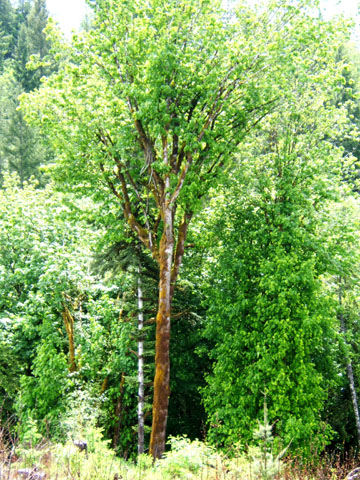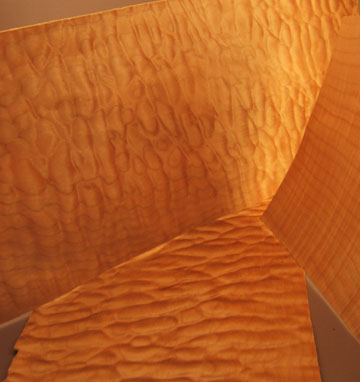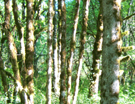Chapter 4: The Best Hardwoods
From A Guide to Innovative Tree Farming in the Pacific Northwest by Mike Dubrasich. 2005. Whirlwind Press. For a hard copy of the book ($10 - includes shipping) please contact W.I.S.E. [here].

Best of the Best: Bigleaf Maple (Acer macrophyllum)
Runners-Up: Oregon Ash (Fraxinus latifolia), Bitter Cherry (Prunus emarginata)
Honorable Mention: Red Alder (Alnus rubra)
Innovative tree farmers do not limit themselves to growing conifers only; hardwood tree species are too profitable not to grow. In fact, hardwoods can be much more profitable than conifers.
Hardwoods are more properly termed broad-leaved, flowering trees. Most hardwood trees native to the Pacific Northwest are deciduous; in contrast, most of our conifers are evergreens. The wood from hardwood trees is not necessarily hard, but hardwood wood does have a slightly different cellular structure than conifer wood.
Bigleaf maple
Of the hundreds of native hardwood tree species, bigleaf maple is the best of the best to grow on Pacific Northwest tree farms. It’s very fast-growing, easy to grow, produces multiple high-value products starting at a young age, and provides opportunities to add value.
The natural range of bigleaf maple is larger than that of western red cedar, extending from Alaska to central California and east to Idaho. Moreover, bigleaf maple occurs naturally on more varied sites. It does best on moist sites with deep soils and often grows with western cedar in forests, but bigleaf maple occupies dryer forest sites, as well. It is so ubiquitous that many people, Douglas-fir tree farmers in particular, consider bigleaf maple to be a common and bothersome weed.
It was not always so. Bigleaf maple was for many millennia a plant treasured and utilized extensively by the local residents. The Indians used the inner bark, outer bark, and wood for fiber, medicine, dyes, tools, utensils, toys, and religious objects. The modern uses include all of the above and much more.
Bigleaf maple is easy to grow. The big seeds are easy to collect, have a high rate of germination, and produce big seedlings that out-plant very successfully. On most sites bigleaf maple will out-grow any other native tree for the first twenty years. In dense stands trees retain good epinastic control (growing straight up with a single apical leader for many decades). Grown on a good site, trees will reach 40 to 50 feet in height in 15 years and over 80 feet tall in 50 years. At age 20 diameters at breast height can be 18 inches or more, and 50-year-old bigleaf maples can measure 3 to 4 feet dbh.
The wood from bigleaf maple is softer than other maples, but has the same satiny sheen. Clear wood garners premium prices for furniture, cabinetry, and molding. Figured bigleaf maple wood is even more valuable.
Bigleaf maple is one of the world’s most exquisite and desirable figured woods. Curly grain, fiddleback, blister, quilt, and tiger stripe are some of the terms used to describe the visually-attractive grain patterns in figured wood. Figured maple is used for musical instruments, furniture, cabinetry, and arts and crafts of all kinds. Manufacturers slice (not saw) figured logs and cants into wafer-thin veneers they sell by the square foot (not the board foot). When figured maple is sliced, it can reach exorbitant price levels translating to as much as $150 per original board foot. Bigleaf maple is also one of a handful of native species that that form commercial burls.

Tree farmers can induce figure in bigleaf maple trees. Curly and quilted grain is caused by irregular cell growth in response to compression. Bigleaf maple has a genetic propensity for such growth, and small areas of figure occur on nearly every tree. Figure most often occurs in compression wood: under branches, on the downhill side of leaning trees, and in the sapwood of trees with heart rot. Innovative tree farmers induce figure by gently bending and tying over saplings for one spring growing season. In mid-summer the trees are straightened up, but permanent wrinkles are left in the hardened spring wood. As the trees put on new layers of cambium each year thereafter, the wrinkles repeat and expand outward. Tying over the bigleaf maple saplings in the opposite direction during a second season induces permanent figure on the other side of the trees, too.
Inducing figure may seem like a lot of work, but it’s worth it. A local tree farmer recently harvested and sold a figured bigleaf maple tree, 42 years-old with a dbh of 36 inches. About 1,000 board feet in log scale were harvested from the tree and sold FOB for $10 per board foot, a total of $10,000 for one tree. Any tree worth $10,000 at age 42 ought to be of eye-opening interest to tree farmers.
On good sites bigleaf maples can have amazingly rapid diameter growth, as much as 2 inches per year. Wide growth rings do not degrade prices in figured maple wood, so the faster the growth, the better. An acre of 50-year-old maples can contain more than 50,000 board feet in large logs. If the trees have figure induced by the tree farmer, that acre could potentially have a crop worth $500,000 (compare that to the $15,000 per acre value of 50-year-old Douglas-fir!)
Thinning young stands of bigleaf maple can yield commercial products, too. The inner bark is one of the most beautiful craft fibers produced in the Pacific Northwest. It’s strong, pliant, and as with western red cedar inner bark, fiber artisans have used it for thousands of years. A 20-year-old tree pruned to 25 feet can yield $50 to $80 worth of inner bark.
The outer bark of bigleaf maple is also useful, as a natural dye. The cork remaining after peeling the inner bark can be chopped, dried, and packaged in cloth dye bags for retail sale. Tannic acid in the outer bark gives a range of brown colors to dyestuffs.
Stumps of bigleaf maple sprout new shoots after logging. No other species sprout so abundantly and vigorously. One-year-old stump sprouts (called canes) are another desirable craft fiber, and are used in basketry and furniture making. Bigleaf maple canes can be 6 to 8 feet long, with 10 or more commercial-quality canes per stump. This type plant management is known as coppicing, a centuries-old tree farming technique. Coppicing can be very profitable today when applied to bigleaf maple. One or two canes on each stump can be left to grow into new trees. Bigleaf maple trees growing from stump sprouts put on amazing height growth, over 6 feet per year for the first few years.
Bigleaf maple can be grown in pure stands or companion-planted with western red cedar. The maples shade the cedars and improve the soil. If pruned, stands as young as 10 to 15-years-old can be commercially thinned for bark, and trees with induced, incipient figure left to develop further. The cedars provide an advanced replacement crop when the figured maples are cut and coppiced at age 40 or 50.
Bigleaf maple, properly cultured, is the most profitable tree species to grow on Pacific Northwest tree farms. It has the potential to out-perform Douglas-fir by more than 40 to 1. Most people reading this will not believe it, or will not act on it. Only a few, bold, innovative tree farmers will realize the potential for amazing profits from bigleaf maple.
Bitter Cherry and Oregon Ash
Bitter cherry and Oregon ash are also excellent tree farm species. Neither produces as many commercial products as bigleaf maple, but they do produce some very valuable ones.
Bitter cherry is a very common “weed” tree that occurs naturally throughout the Pacific Northwest. It produces small cherries favored by every fruit-eating bird and mammal, and is thus spread everywhere. Bitter cherry is a very fast growing tree on wet and dry sites, and retains good epinastic control in dense stands. A plantation-grown bitter cherry can be over 40 feet tall in 20 years with clear bark to 25 feet if pruned.
Bitter cherry’s best product is its outer bark. The principal fibers in cherry bark are horizontal, running circumferentially around the trunk rather than vertically. Bitter cherry bark has curly strands, rich colors, intricate patterns inside and out, and is highly desired by artisans. At $2 to $4 apiece retail for one-foot bark sections, a bitter cherry can be worth $50 to $100 at age 20. Tree farmers may also select leave trees to grow clear cherry wood, also of high value.

Oregon ash occurs naturally on wet sites throughout the Pacific Northwest, but also grows well in other habitats and soil conditions. Many of our native plants grow better in managed tree farm plantations than they do in their natural habitats.
Small Oregon ash logs can be processed into splints. Ash splints are traditionally made by pounding logs. Pounding compresses the soft spring wood into the harder summer wood, causing the log to delaminate along its annual rings. Splint makers cut delaminated sections to widths of an inch or less and sand one or two sides to enhance the natural luster. Ash splints typically are 4 to 6 feet long and sold retail in rolls of 10 for $20. A single 25-year-old ash tree can produce $500 worth of ash splints, or more. Traditionalists and native artisans still hand-pound ash logs, but commercial producers use hammer or roller mills. Ash splints are also made by rotary veneer slicing, but these are less favored by the artisan market.
Most commercial ash splint makers today use black ash, Fraxinus nigra, which grows in the northeastern U.S. and southeastern Canada. Splints from Oregon ash, however, have all the same qualities as black ash splints, plus a brighter white coloration.
Pruned Oregon ash trees can be harvested for splints at age 25, with selected trees of good form left to grow. Clear Oregon ash wood is worth about five times Douglas-fir wood by the board foot.
Red Alder
Honorable Mention goes to red alder. Red alder is widely grown for timber and thus a mass-produced commodity, but it has some qualities that make it an attractive tree for innovative tree farming.
Red alder occurs west of the Pacific Crest from Alaska to southern California and does well in tree farm plantations. Red alder has root nodules that harbor nitrogen-fixing bacteria, and so fertilizes itself and neighboring trees. This makes it a nice companion-plant for other tree species.
Red alder is fast-growing and can reach heights of 40 feet or more in 20 years. The outer bark makes a desirable natural dye, and if pruned, alder makes clear, white wood. Red alder wood is a substitute wood; veneer manufacturers stain it to make it look like many other kinds of wood. Currently, the demand for veneer grade alder logs is expanding. To make veneer grade an alder log must measure at least 16 inches in diameter at the small end, and it can take red alder trees 30 or 40 years to reach this size. Red alder grows faster and produces greater profits than Douglas-fir, but is not as profitable to grow as bigleaf maple, bitter cherry, or Oregon ash. Red alder’s soil building capacity is the factor that makes it a desirable tree to companion plant with trees of more profitable species.
Hardwoods are an important component of successful Pacific Northwest tree farms. Innovative tree farmers do not grow conifers exclusively; they do not wish to miss out on the profit-making opportunities hardwoods provide. In fact, it‘s conifers, not hardwoods, that may be missing from innovative tree farms of the future.
